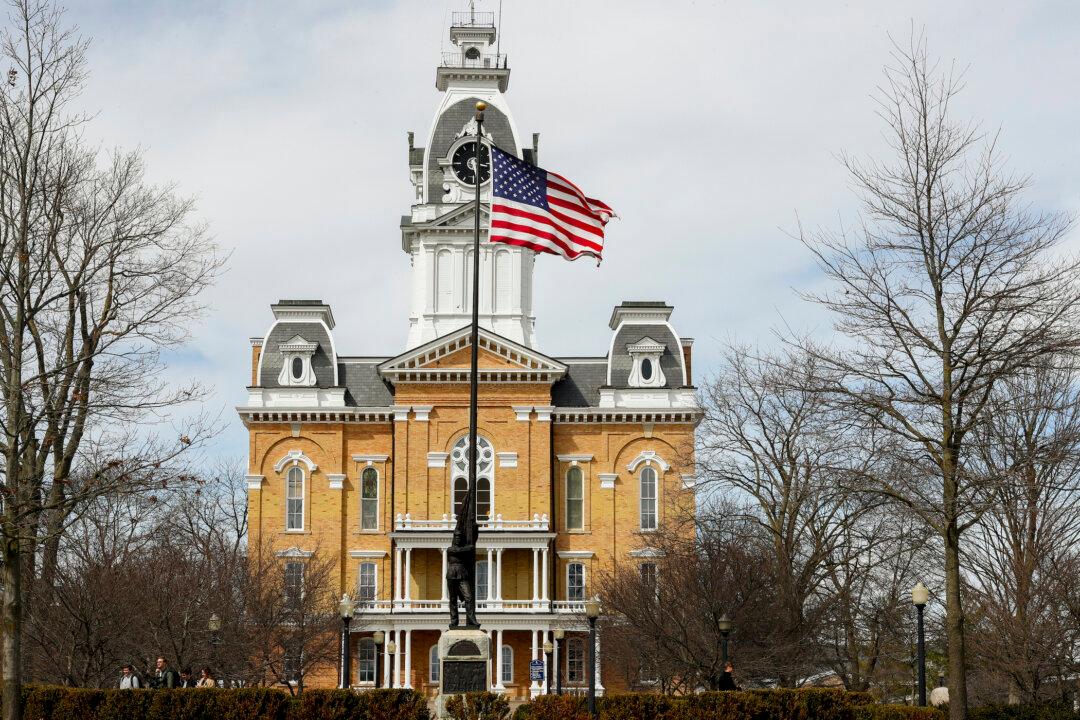On the afternoon of Oct. 24, the blue sky above Amundsen Park was marred by dark smoke. Something had caught on fire a few blocks away.
A whitish haze filled the streets, dissipating as quickly as it had appeared. The fire was out.
A Chicago Park District SUV was parked just outside the fieldhouse. Although the building’s door was open, a guard tightly controlled access. The bathroom was open, but that was pretty much it.

In Chicago’s Galewood neighborhood, locals are putting up a fight to keep their fieldhouse, one of many public spaces suddenly set to house thousands of illegal immigrants that have flooded one of America’s deep blue “sanctuary cities.”

Protests, legal filings, and negotiations over a nearby alternative mean that area residents haven’t yet lost an anchor of their community to individuals who are in the country illegally or, in many cases, are on parole under the Biden administration’s laxer immigration policies. For now, though, everything is up in the air.
“It looks like the city is keeping it in a state of suspension in case they have to use it as a shelter,” said Pericles “Perry” Abassi, a lawyer who has been heavily involved in many aspects of the Amundsen odyssey in an Oct. 26 interview with The Epoch Times.
“I grew up in Galewood,” Mr. Abassi said, noting that his parents still reside in the neighborhood. He added that he and his fiancée love the community.
29th Ward Alderman Chris Taliaferro helped ignite fears of a fieldhouse takeover early this month. In an Oct. 2 Facebook post and email, he wrote that Mayor Brandon Johnson’s deputy chief of staff had informed him the park would be used to house roughly 200 illegal immigrants.
“I strongly oppose closing Amundsen Park,” the alderman wrote in the post. He announced a community meeting for Oct. 3 at the park.
Similar spaces in the city, such as Broadway Armory Park, have rapidly filled with illegal immigrants over recent months with little to no resistance. But in Galewood, residents didn’t roll over.
“If you want to take the park away from us, why should we pay the Park District’s taxes?” asked Tommy Simmons, a longtime local and member of the Amundsen Park Community Council who spoke with The Epoch Times outside the fieldhouse on Oct. 24.
Both Mr. Simmons and Mr. Abassi have worked to elect Ald. Taliaferro in the past, but Mr. Simmons has soured on him. In Mr. Simmons’ view, the ongoing dispute over Amundsen reflects the alderman’s poor working relationship with Mayor Johnson.
“He [Mr. Taliaferro] wants to blame it on the mayor,” Mr. Simmons said.
Hundreds of Galewood residents flocked to the Oct. 3 meeting, where they made their opposition known. Activist Mark Weyermuller caught the moment when members of the Windy City Dolphins, a youth football program at risk of displacement from the park, walked through the meeting.
Worry and Anger
Worry and anger only mounted with an Oct. 7 draft email from city officials. Citing an “ever-growing humanitarian crisis,” the letter to local parents and community members announced that “the city will be using Amundsen Park as a temporary shelter.”The email announced that park programming would be moved from the fieldhouse starting Oct. 10, just days later. It indicated that, in some cases, activities could be relocated to places miles away—for example, Hiawatha Park, more than 5 miles from Amundsen Park by car as measured by Google Maps. In Chicago, the problem of distance is compounded by gang rivalries, which can jeopardize the safety of kids who venture far from their block.
Locals swiftly sought a restraining order. They invoked the same public trust doctrine that has kept the city’s lakefront an oasis of parkland in a dense urban environment.
“The needs of the children and families in the Austin community have been ignored, while the needs of the migrants have been prioritized,” the complaint reads.
The case is now working its way through Cook County court.

In the meantime, the city started looking into an alternative to the Amundsen fieldhouse, a warehouse and office complex at 1900 N. Austin Ave., where Zenith televisions were once produced. The complex is now home to a hodgepodge of small businesses, ranging from an auto collision center to a spa.
In an Oct. 19 Facebook post, Mr. Taliaferro said the city had already conducted three inspections at the site.
“As far as I can tell, it’s [the fieldhouse is] in a state of suspension right now until the 1900 N. Austin thing is signed,” Mr. Abassi said, noting that nothing is set in stone yet.
Protests Resonate
Whatever happens, the resistance in Galewood has made a mark, both in and beyond the tight-knit neighborhood.“Amundsen really did seem to change the citywide conversation,” Mr. Abassi said.
“Since then, any kind of hearing, whether public or private, people come out to them, and they’re almost totally opposed,” he added.
Outside the fieldhouse on Oct. 24, another Galewood resident, Kieron Scott, explained why he objected to the city’s initial plans for Amundsen.
“We don’t have anything against the migrants. We just don’t want the programs to leave,” the retired United Parcel Service worker told The Epoch Times. He was walking his nine-year-old dog, Duke, in the unseasonably warm weather.

“[The illegal immigrants] are here. They need to be housed. But they don’t need to be in [public] parks,” he added.
Like Mr. Abassi and Mr. Simmons, he has deep roots in the neighborhood. He told The Epoch Times he has lived in the vicinity for two decades.
The connection doesn’t end with him. Three of his grandsons are in the area, and years ago, his son was on the Windy City Dolphins.
“People take pride in where they live at, you know?” he said.
He, too, couldn’t predict how the state of suspension will end. But he expects the people of Galewood to continue resisting as long as they can. That includes more protests that could resonate across the country in the midst of an ongoing migrant crisis and with chaotic scenes still unfolding at the southern border.
“We’re here ‘till the end. This is our community. This is our neighborhood,” he said.
Mr. Taliaferro and the city did not respond to multiple requests for comment from The Epoch Times.







